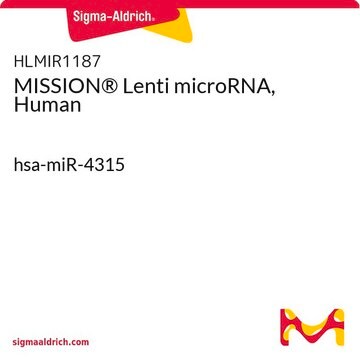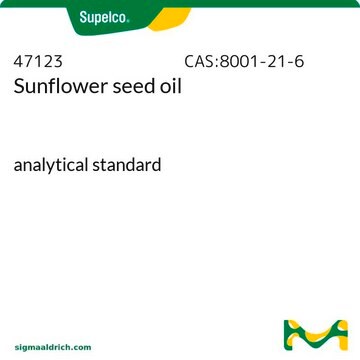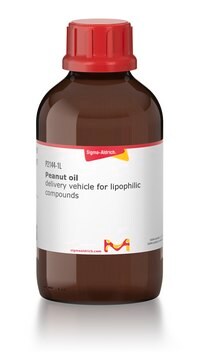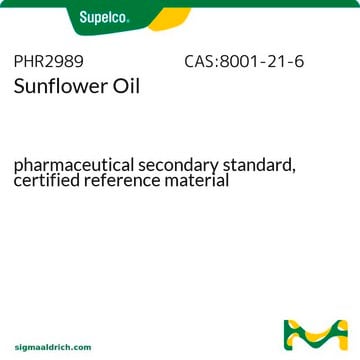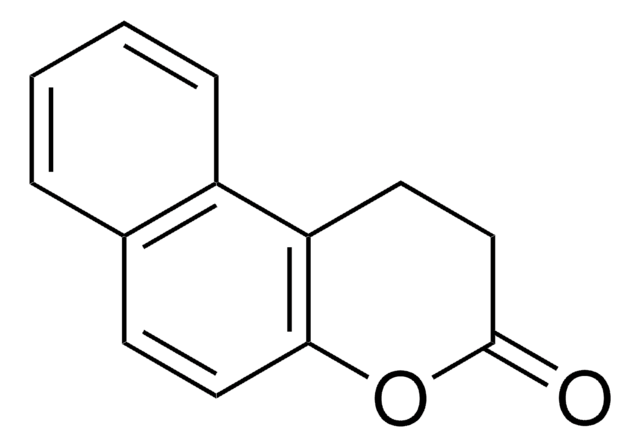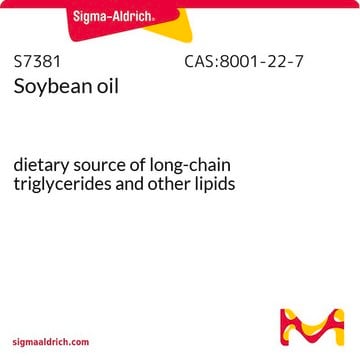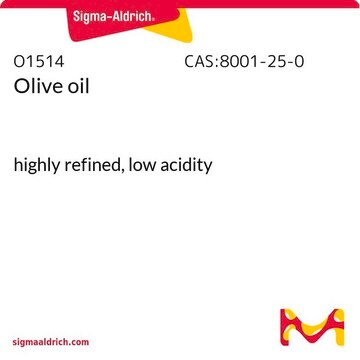S5007
Sunflower seed oil
from Helianthus annuus, liquid, emollient
Sign Into View Organizational & Contract Pricing
All Photos(1)
About This Item
Recommended Products
Product Name
Sunflower seed oil from Helianthus annuus,
density
0.92 g/mL at 25 °C (lit.)
Quality Level
Looking for similar products? Visit Product Comparison Guide
General description
Sunflower seed oil from Helianthus annuus contains saturated fatty acids (palmitic and stearic acids), monounsaturated fatty acid (oleic acid), and polyunsaturated acid (mostly linoleic acid). In addition, this edible oil also contains nonglyceridic contents including tocopherols and plant sterols, and is rich in vitamins and minerals.
Application
Sunflower seed oil from Helianthus annuus was used as a vehicle to administer tamoxifen and 4-hydroxytamoxifen to mice.
Biochem/physiol Actions
Sunflower seed oil is one of the most used vegetable oils in human nutrition. Oilseed crop sunflower (Helianthus annuus) is also used for biodiesel production. Sunflower oil is used as an emollient in cosmetics, and it serves as an effective phenolic antioxidant. Phytosterols in sunflower oil help in regulating the cholesterol levels in the body. Therefore, sunflower oil may be used to treat pathological conditions such as like acne, arthritis, and hair damage.
supp_hazards
Storage Class
10 - Combustible liquids
wgk_germany
WGK 3
flash_point_f
>230.0 °F
flash_point_c
> 110 °C
ppe
Eyeshields, Gloves
Choose from one of the most recent versions:
Certificates of Analysis (COA)
Lot/Batch Number
Don't see the Right Version?
If you require a particular version, you can look up a specific certificate by the Lot or Batch number.
Already Own This Product?
Find documentation for the products that you have recently purchased in the Document Library.
Customers Also Viewed
Rayan Naser et al.
Scientific reports, 6, 20230-20230 (2016-02-06)
Adult neural stem cells (aNSCs) are relatively quiescent populations that give rise to distinct neuronal subtypes throughout life, yet, at a very low rate and restricted differentiation potential. Thus, identifying the molecular mechanisms that control their cellular expansion is critical
Vegetable oils: Dietary importance
"Reference Module in Food Science (2016)
Mariya Tarazanova et al.
PloS one, 14(7), e0220048-e0220048 (2019-07-26)
Microbial surface properties are important for interactions with the environment in which cells reside. Surface properties of lactic acid bacteria significantly vary and some strains can form strong emulsions when mixed with a hydrocarbon. Lactococcus lactis NCDO712 forms oil-in-water emulsions
Andria R Robinson et al.
Redox biology, 17, 259-273 (2018-05-11)
Accumulation of senescent cells over time contributes to aging and age-related diseases. However, what drives senescence in vivo is not clear. Here we used a genetic approach to determine if spontaneous nuclear DNA damage is sufficient to initiate senescence in
Takayuki Hirota et al.
Biology of reproduction, 85(2), 367-377 (2011-04-29)
Germ cells ensure the diversification and totipotency of genetic information via the elaborate genetic and epigenetic regulation of the genome architecture during their development. To understand the mechanism underlying the regulation of genome function in germ cells, it is of
Articles
Discover Bioactive Small Molecules for Lipid Signaling Research
Our team of scientists has experience in all areas of research including Life Science, Material Science, Chemical Synthesis, Chromatography, Analytical and many others.
Contact Technical Service

